Food Production: Different Methods and Influences on Kitchen Design
VerifiedAdded on 2023/01/10
|10
|2802
|72
AI Summary
This article explores the range of food preparation and production systems used in the hospitality industry. It discusses the different methods such as frying, microwave cooking, and grill style, and how they are designed to meet the requirements of businesses and customers. It also examines the influences on kitchen design for efficient food production.
Contribute Materials
Your contribution can guide someone’s learning journey. Share your
documents today.
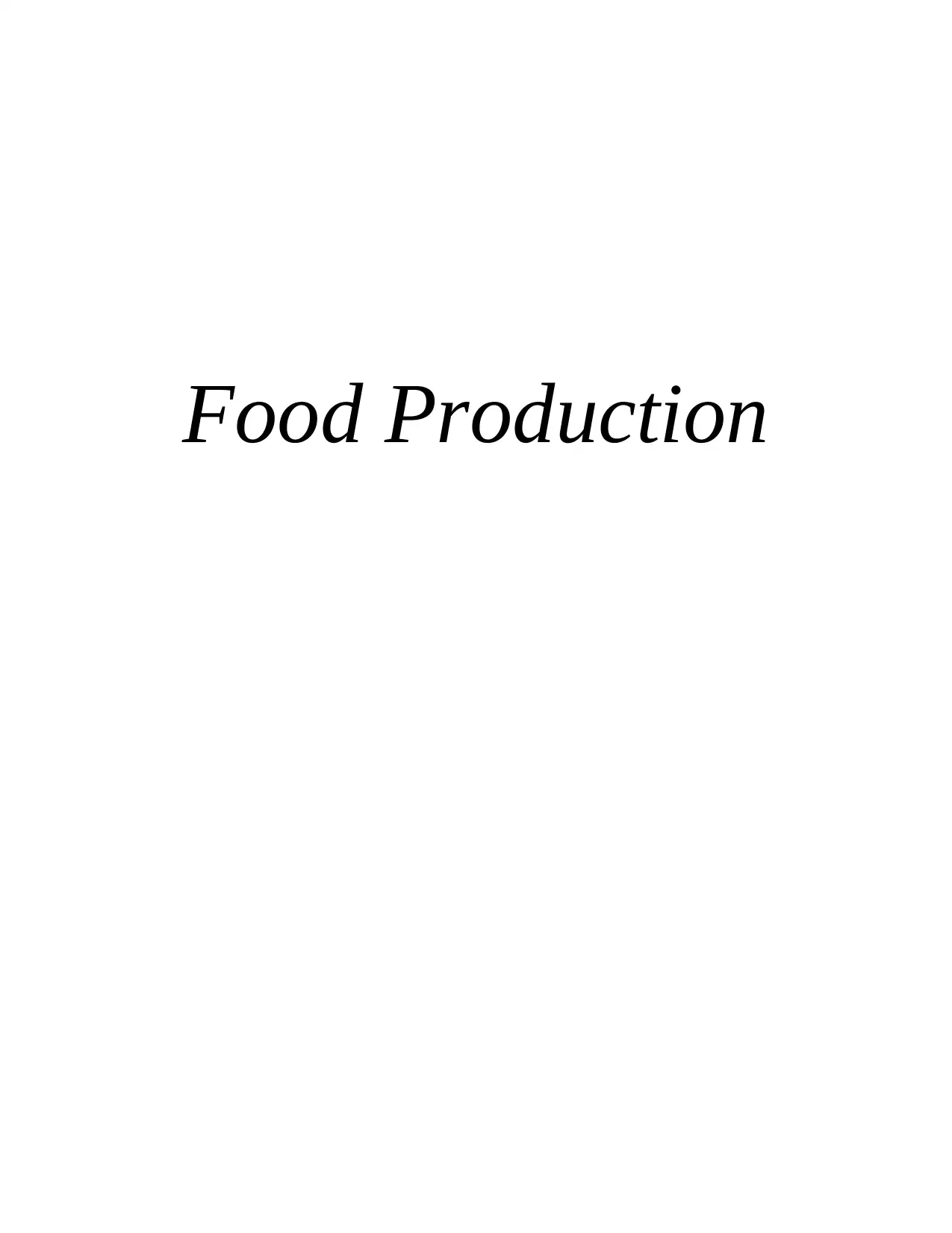
Food Production
Secure Best Marks with AI Grader
Need help grading? Try our AI Grader for instant feedback on your assignments.
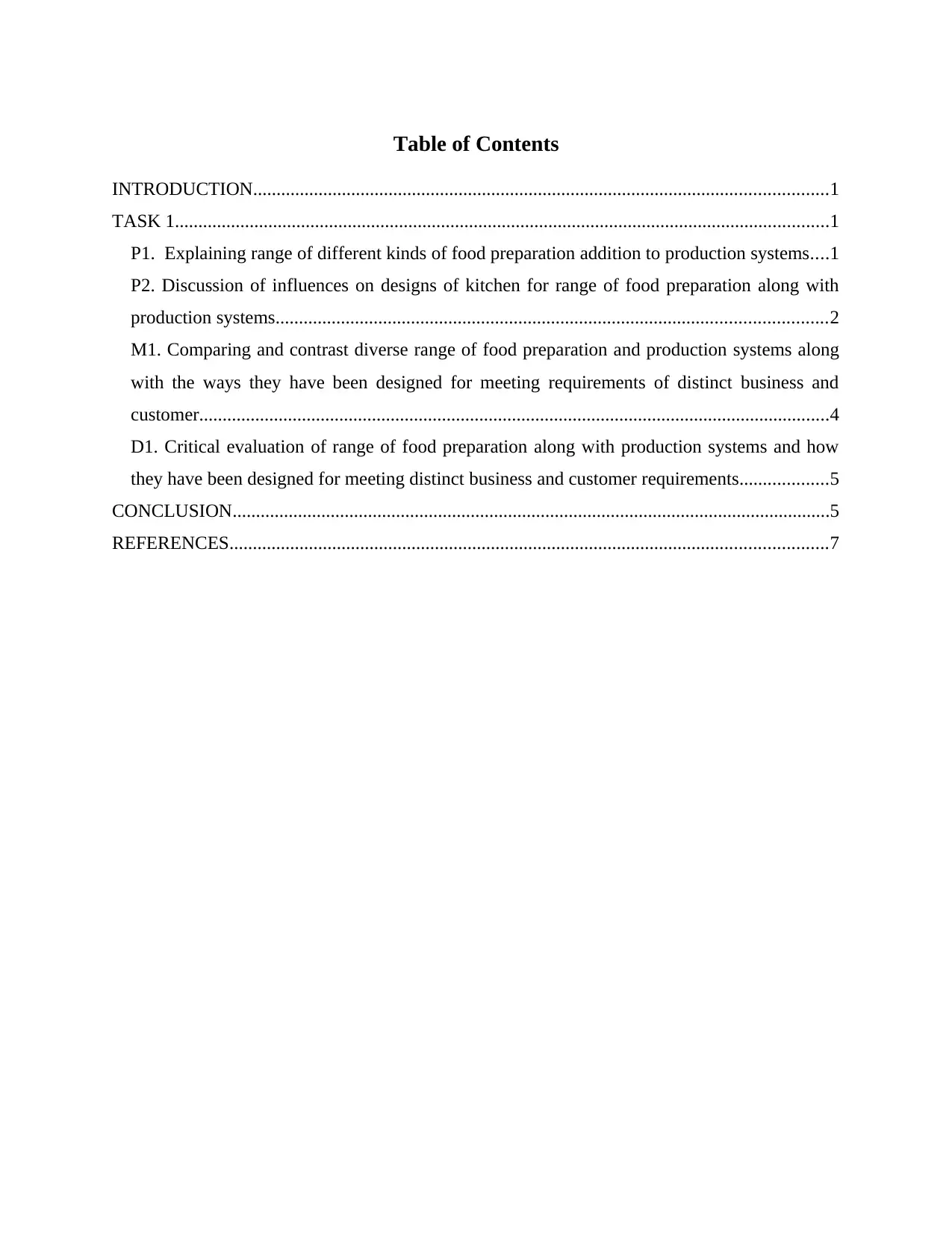
Table of Contents
INTRODUCTION...........................................................................................................................1
TASK 1............................................................................................................................................1
P1. Explaining range of different kinds of food preparation addition to production systems....1
P2. Discussion of influences on designs of kitchen for range of food preparation along with
production systems......................................................................................................................2
M1. Comparing and contrast diverse range of food preparation and production systems along
with the ways they have been designed for meeting requirements of distinct business and
customer.......................................................................................................................................4
D1. Critical evaluation of range of food preparation along with production systems and how
they have been designed for meeting distinct business and customer requirements...................5
CONCLUSION................................................................................................................................5
REFERENCES................................................................................................................................7
INTRODUCTION...........................................................................................................................1
TASK 1............................................................................................................................................1
P1. Explaining range of different kinds of food preparation addition to production systems....1
P2. Discussion of influences on designs of kitchen for range of food preparation along with
production systems......................................................................................................................2
M1. Comparing and contrast diverse range of food preparation and production systems along
with the ways they have been designed for meeting requirements of distinct business and
customer.......................................................................................................................................4
D1. Critical evaluation of range of food preparation along with production systems and how
they have been designed for meeting distinct business and customer requirements...................5
CONCLUSION................................................................................................................................5
REFERENCES................................................................................................................................7
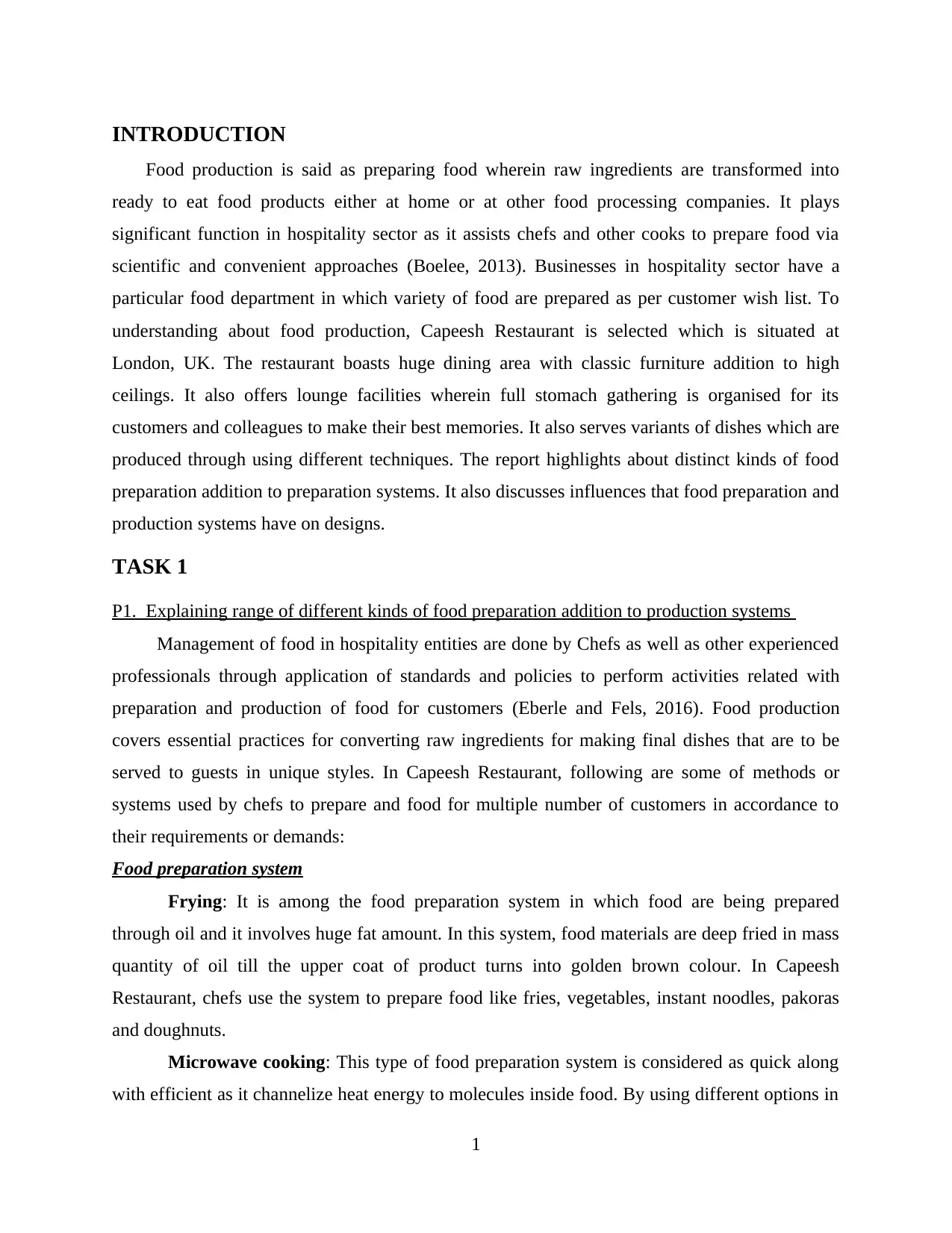
INTRODUCTION
Food production is said as preparing food wherein raw ingredients are transformed into
ready to eat food products either at home or at other food processing companies. It plays
significant function in hospitality sector as it assists chefs and other cooks to prepare food via
scientific and convenient approaches (Boelee, 2013). Businesses in hospitality sector have a
particular food department in which variety of food are prepared as per customer wish list. To
understanding about food production, Capeesh Restaurant is selected which is situated at
London, UK. The restaurant boasts huge dining area with classic furniture addition to high
ceilings. It also offers lounge facilities wherein full stomach gathering is organised for its
customers and colleagues to make their best memories. It also serves variants of dishes which are
produced through using different techniques. The report highlights about distinct kinds of food
preparation addition to preparation systems. It also discusses influences that food preparation and
production systems have on designs.
TASK 1
P1. Explaining range of different kinds of food preparation addition to production systems
Management of food in hospitality entities are done by Chefs as well as other experienced
professionals through application of standards and policies to perform activities related with
preparation and production of food for customers (Eberle and Fels, 2016). Food production
covers essential practices for converting raw ingredients for making final dishes that are to be
served to guests in unique styles. In Capeesh Restaurant, following are some of methods or
systems used by chefs to prepare and food for multiple number of customers in accordance to
their requirements or demands:
Food preparation system
Frying: It is among the food preparation system in which food are being prepared
through oil and it involves huge fat amount. In this system, food materials are deep fried in mass
quantity of oil till the upper coat of product turns into golden brown colour. In Capeesh
Restaurant, chefs use the system to prepare food like fries, vegetables, instant noodles, pakoras
and doughnuts.
Microwave cooking: This type of food preparation system is considered as quick along
with efficient as it channelize heat energy to molecules inside food. By using different options in
1
Food production is said as preparing food wherein raw ingredients are transformed into
ready to eat food products either at home or at other food processing companies. It plays
significant function in hospitality sector as it assists chefs and other cooks to prepare food via
scientific and convenient approaches (Boelee, 2013). Businesses in hospitality sector have a
particular food department in which variety of food are prepared as per customer wish list. To
understanding about food production, Capeesh Restaurant is selected which is situated at
London, UK. The restaurant boasts huge dining area with classic furniture addition to high
ceilings. It also offers lounge facilities wherein full stomach gathering is organised for its
customers and colleagues to make their best memories. It also serves variants of dishes which are
produced through using different techniques. The report highlights about distinct kinds of food
preparation addition to preparation systems. It also discusses influences that food preparation and
production systems have on designs.
TASK 1
P1. Explaining range of different kinds of food preparation addition to production systems
Management of food in hospitality entities are done by Chefs as well as other experienced
professionals through application of standards and policies to perform activities related with
preparation and production of food for customers (Eberle and Fels, 2016). Food production
covers essential practices for converting raw ingredients for making final dishes that are to be
served to guests in unique styles. In Capeesh Restaurant, following are some of methods or
systems used by chefs to prepare and food for multiple number of customers in accordance to
their requirements or demands:
Food preparation system
Frying: It is among the food preparation system in which food are being prepared
through oil and it involves huge fat amount. In this system, food materials are deep fried in mass
quantity of oil till the upper coat of product turns into golden brown colour. In Capeesh
Restaurant, chefs use the system to prepare food like fries, vegetables, instant noodles, pakoras
and doughnuts.
Microwave cooking: This type of food preparation system is considered as quick along
with efficient as it channelize heat energy to molecules inside food. By using different options in
1

microwave, chefs of Capeesh Restaurant prepare food for customers through frictional heat that
is produces or created via vibration in food.
Grill style: This food preparation method is most liked as well as popular method among
others. In grill cooking, food item are prepared through applying dry heat from below or above
the product. Cordon bleu of Capeesh Restaurant uses grill style for preparing grilled meats,
kebabs and other recipe that people are fond of.
Food production system:
Sous Vide system: It is one of food production system in which food is put within plastic
pouch or large glass jar for cooling it in water bath for huge time than normal durations (Food
production system, 2015). The main objective of using the food production method by chefs of
Capeesh Restaurant is to rationalise kitchen actions without any unfavourable effect on quality
and worthy of individual dishes.
Cook chill system: Another food production system that is based in normal preparation
addition to cooking of food by following rapid chilling and storing it in controlled temperature
conditions just above freezing points that are 0 degree C to 3 degree C. By using the method,
Chefs of Capeesh Restaurant produces food by reheating the cook chill food before serving to
guests.
Cook Freeze system: Food production system in which food is cooked as well as frozen at
negative 20 degree temperature at places where food is produced is said to cook freeze system.
With cook freeze system, food and beverage department of Capeesh Restaurant is able to keep
the food placed up to 7 – 8 weeks prior to reheating or cooking dishes for purpose of eating.
By using the mentioned systems of food production and preparation, chefs of Capeesh
Restaurant meet demand of customers for different food and this attracts large customer towards
it that leads to making unique position in the city.
P2. Discussion of influences on designs of kitchen for range of food preparation along with
production systems
Kitchen is the place or part of building wherein food are prepared and produced in varied
manner (Jayne, 2012). Food preparation methods are also influenced and influences designs of
kitchen. In this context, managers of Capeesh Restaurant have explored the factors which
2
is produces or created via vibration in food.
Grill style: This food preparation method is most liked as well as popular method among
others. In grill cooking, food item are prepared through applying dry heat from below or above
the product. Cordon bleu of Capeesh Restaurant uses grill style for preparing grilled meats,
kebabs and other recipe that people are fond of.
Food production system:
Sous Vide system: It is one of food production system in which food is put within plastic
pouch or large glass jar for cooling it in water bath for huge time than normal durations (Food
production system, 2015). The main objective of using the food production method by chefs of
Capeesh Restaurant is to rationalise kitchen actions without any unfavourable effect on quality
and worthy of individual dishes.
Cook chill system: Another food production system that is based in normal preparation
addition to cooking of food by following rapid chilling and storing it in controlled temperature
conditions just above freezing points that are 0 degree C to 3 degree C. By using the method,
Chefs of Capeesh Restaurant produces food by reheating the cook chill food before serving to
guests.
Cook Freeze system: Food production system in which food is cooked as well as frozen at
negative 20 degree temperature at places where food is produced is said to cook freeze system.
With cook freeze system, food and beverage department of Capeesh Restaurant is able to keep
the food placed up to 7 – 8 weeks prior to reheating or cooking dishes for purpose of eating.
By using the mentioned systems of food production and preparation, chefs of Capeesh
Restaurant meet demand of customers for different food and this attracts large customer towards
it that leads to making unique position in the city.
P2. Discussion of influences on designs of kitchen for range of food preparation along with
production systems
Kitchen is the place or part of building wherein food are prepared and produced in varied
manner (Jayne, 2012). Food preparation methods are also influenced and influences designs of
kitchen. In this context, managers of Capeesh Restaurant have explored the factors which
2
Secure Best Marks with AI Grader
Need help grading? Try our AI Grader for instant feedback on your assignments.
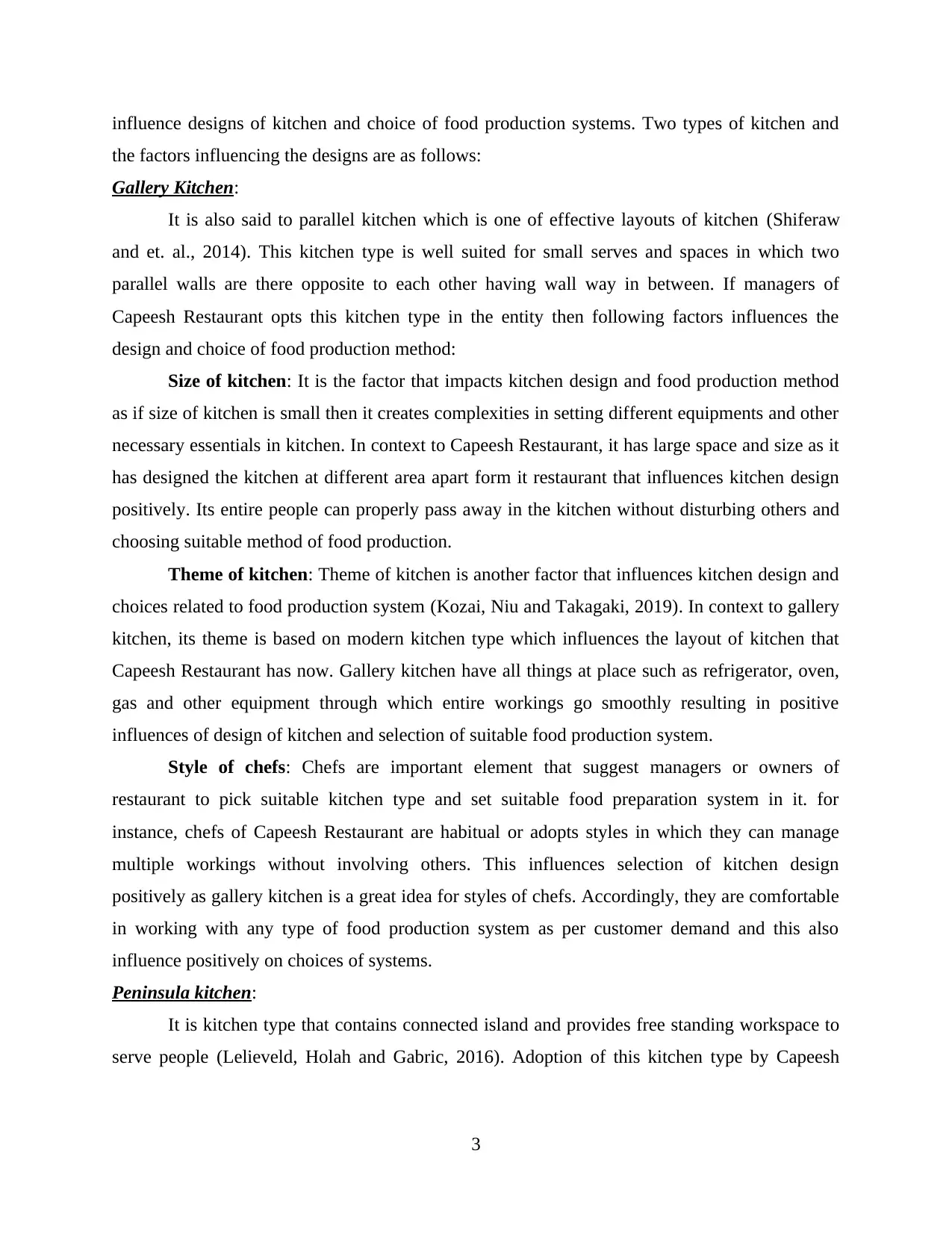
influence designs of kitchen and choice of food production systems. Two types of kitchen and
the factors influencing the designs are as follows:
Gallery Kitchen:
It is also said to parallel kitchen which is one of effective layouts of kitchen (Shiferaw
and et. al., 2014). This kitchen type is well suited for small serves and spaces in which two
parallel walls are there opposite to each other having wall way in between. If managers of
Capeesh Restaurant opts this kitchen type in the entity then following factors influences the
design and choice of food production method:
Size of kitchen: It is the factor that impacts kitchen design and food production method
as if size of kitchen is small then it creates complexities in setting different equipments and other
necessary essentials in kitchen. In context to Capeesh Restaurant, it has large space and size as it
has designed the kitchen at different area apart form it restaurant that influences kitchen design
positively. Its entire people can properly pass away in the kitchen without disturbing others and
choosing suitable method of food production.
Theme of kitchen: Theme of kitchen is another factor that influences kitchen design and
choices related to food production system (Kozai, Niu and Takagaki, 2019). In context to gallery
kitchen, its theme is based on modern kitchen type which influences the layout of kitchen that
Capeesh Restaurant has now. Gallery kitchen have all things at place such as refrigerator, oven,
gas and other equipment through which entire workings go smoothly resulting in positive
influences of design of kitchen and selection of suitable food production system.
Style of chefs: Chefs are important element that suggest managers or owners of
restaurant to pick suitable kitchen type and set suitable food preparation system in it. for
instance, chefs of Capeesh Restaurant are habitual or adopts styles in which they can manage
multiple workings without involving others. This influences selection of kitchen design
positively as gallery kitchen is a great idea for styles of chefs. Accordingly, they are comfortable
in working with any type of food production system as per customer demand and this also
influence positively on choices of systems.
Peninsula kitchen:
It is kitchen type that contains connected island and provides free standing workspace to
serve people (Lelieveld, Holah and Gabric, 2016). Adoption of this kitchen type by Capeesh
3
the factors influencing the designs are as follows:
Gallery Kitchen:
It is also said to parallel kitchen which is one of effective layouts of kitchen (Shiferaw
and et. al., 2014). This kitchen type is well suited for small serves and spaces in which two
parallel walls are there opposite to each other having wall way in between. If managers of
Capeesh Restaurant opts this kitchen type in the entity then following factors influences the
design and choice of food production method:
Size of kitchen: It is the factor that impacts kitchen design and food production method
as if size of kitchen is small then it creates complexities in setting different equipments and other
necessary essentials in kitchen. In context to Capeesh Restaurant, it has large space and size as it
has designed the kitchen at different area apart form it restaurant that influences kitchen design
positively. Its entire people can properly pass away in the kitchen without disturbing others and
choosing suitable method of food production.
Theme of kitchen: Theme of kitchen is another factor that influences kitchen design and
choices related to food production system (Kozai, Niu and Takagaki, 2019). In context to gallery
kitchen, its theme is based on modern kitchen type which influences the layout of kitchen that
Capeesh Restaurant has now. Gallery kitchen have all things at place such as refrigerator, oven,
gas and other equipment through which entire workings go smoothly resulting in positive
influences of design of kitchen and selection of suitable food production system.
Style of chefs: Chefs are important element that suggest managers or owners of
restaurant to pick suitable kitchen type and set suitable food preparation system in it. for
instance, chefs of Capeesh Restaurant are habitual or adopts styles in which they can manage
multiple workings without involving others. This influences selection of kitchen design
positively as gallery kitchen is a great idea for styles of chefs. Accordingly, they are comfortable
in working with any type of food production system as per customer demand and this also
influence positively on choices of systems.
Peninsula kitchen:
It is kitchen type that contains connected island and provides free standing workspace to
serve people (Lelieveld, Holah and Gabric, 2016). Adoption of this kitchen type by Capeesh
3
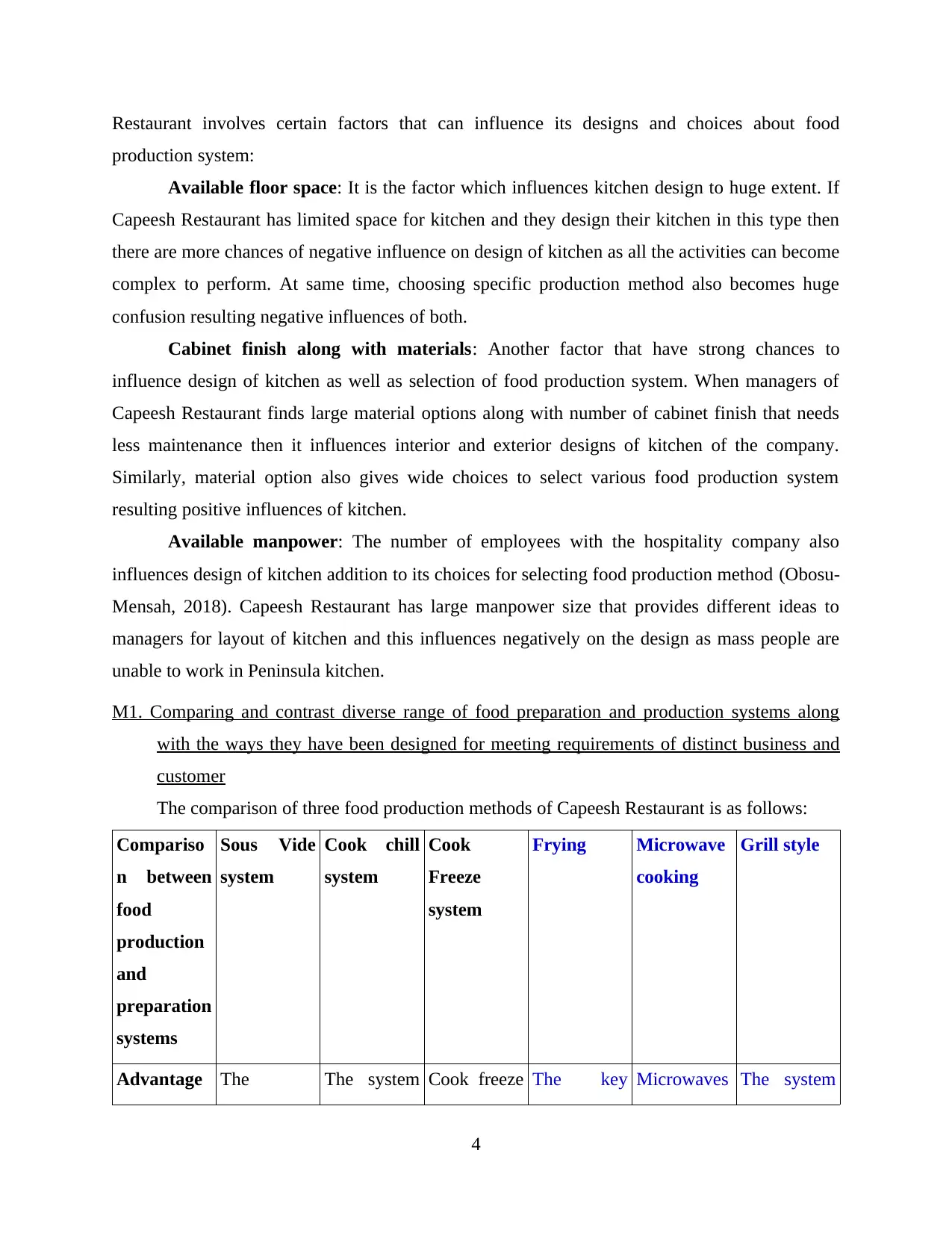
Restaurant involves certain factors that can influence its designs and choices about food
production system:
Available floor space: It is the factor which influences kitchen design to huge extent. If
Capeesh Restaurant has limited space for kitchen and they design their kitchen in this type then
there are more chances of negative influence on design of kitchen as all the activities can become
complex to perform. At same time, choosing specific production method also becomes huge
confusion resulting negative influences of both.
Cabinet finish along with materials: Another factor that have strong chances to
influence design of kitchen as well as selection of food production system. When managers of
Capeesh Restaurant finds large material options along with number of cabinet finish that needs
less maintenance then it influences interior and exterior designs of kitchen of the company.
Similarly, material option also gives wide choices to select various food production system
resulting positive influences of kitchen.
Available manpower: The number of employees with the hospitality company also
influences design of kitchen addition to its choices for selecting food production method (Obosu-
Mensah, 2018). Capeesh Restaurant has large manpower size that provides different ideas to
managers for layout of kitchen and this influences negatively on the design as mass people are
unable to work in Peninsula kitchen.
M1. Comparing and contrast diverse range of food preparation and production systems along
with the ways they have been designed for meeting requirements of distinct business and
customer
The comparison of three food production methods of Capeesh Restaurant is as follows:
Compariso
n between
food
production
and
preparation
systems
Sous Vide
system
Cook chill
system
Cook
Freeze
system
Frying Microwave
cooking
Grill style
Advantage The The system Cook freeze The key Microwaves The system
4
production system:
Available floor space: It is the factor which influences kitchen design to huge extent. If
Capeesh Restaurant has limited space for kitchen and they design their kitchen in this type then
there are more chances of negative influence on design of kitchen as all the activities can become
complex to perform. At same time, choosing specific production method also becomes huge
confusion resulting negative influences of both.
Cabinet finish along with materials: Another factor that have strong chances to
influence design of kitchen as well as selection of food production system. When managers of
Capeesh Restaurant finds large material options along with number of cabinet finish that needs
less maintenance then it influences interior and exterior designs of kitchen of the company.
Similarly, material option also gives wide choices to select various food production system
resulting positive influences of kitchen.
Available manpower: The number of employees with the hospitality company also
influences design of kitchen addition to its choices for selecting food production method (Obosu-
Mensah, 2018). Capeesh Restaurant has large manpower size that provides different ideas to
managers for layout of kitchen and this influences negatively on the design as mass people are
unable to work in Peninsula kitchen.
M1. Comparing and contrast diverse range of food preparation and production systems along
with the ways they have been designed for meeting requirements of distinct business and
customer
The comparison of three food production methods of Capeesh Restaurant is as follows:
Compariso
n between
food
production
and
preparation
systems
Sous Vide
system
Cook chill
system
Cook
Freeze
system
Frying Microwave
cooking
Grill style
Advantage The The system Cook freeze The key Microwaves The system
4
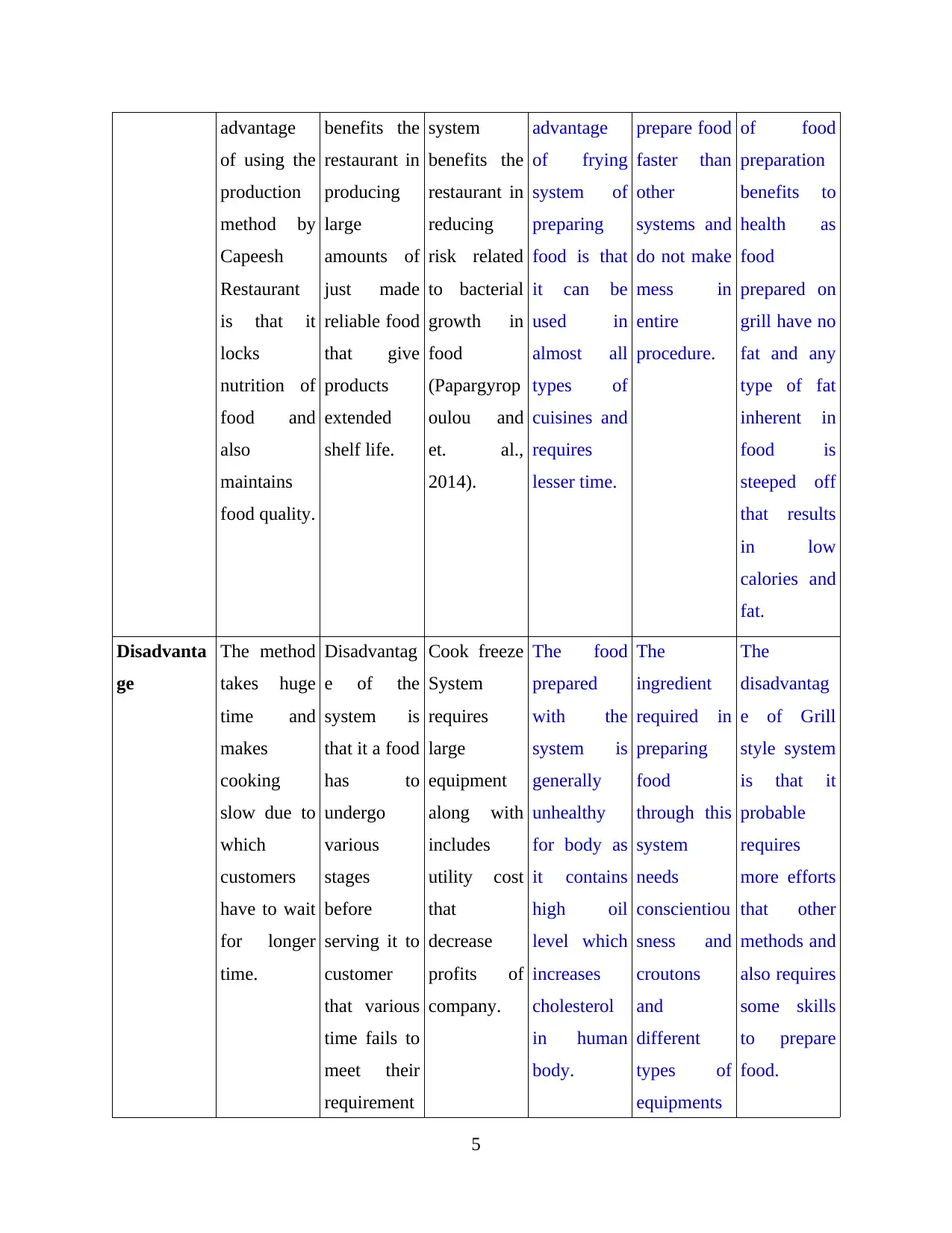
advantage
of using the
production
method by
Capeesh
Restaurant
is that it
locks
nutrition of
food and
also
maintains
food quality.
benefits the
restaurant in
producing
large
amounts of
just made
reliable food
that give
products
extended
shelf life.
system
benefits the
restaurant in
reducing
risk related
to bacterial
growth in
food
(Papargyrop
oulou and
et. al.,
2014).
advantage
of frying
system of
preparing
food is that
it can be
used in
almost all
types of
cuisines and
requires
lesser time.
prepare food
faster than
other
systems and
do not make
mess in
entire
procedure.
of food
preparation
benefits to
health as
food
prepared on
grill have no
fat and any
type of fat
inherent in
food is
steeped off
that results
in low
calories and
fat.
Disadvanta
ge
The method
takes huge
time and
makes
cooking
slow due to
which
customers
have to wait
for longer
time.
Disadvantag
e of the
system is
that it a food
has to
undergo
various
stages
before
serving it to
customer
that various
time fails to
meet their
requirement
Cook freeze
System
requires
large
equipment
along with
includes
utility cost
that
decrease
profits of
company.
The food
prepared
with the
system is
generally
unhealthy
for body as
it contains
high oil
level which
increases
cholesterol
in human
body.
The
ingredient
required in
preparing
food
through this
system
needs
conscientiou
sness and
croutons
and
different
types of
equipments
The
disadvantag
e of Grill
style system
is that it
probable
requires
more efforts
that other
methods and
also requires
some skills
to prepare
food.
5
of using the
production
method by
Capeesh
Restaurant
is that it
locks
nutrition of
food and
also
maintains
food quality.
benefits the
restaurant in
producing
large
amounts of
just made
reliable food
that give
products
extended
shelf life.
system
benefits the
restaurant in
reducing
risk related
to bacterial
growth in
food
(Papargyrop
oulou and
et. al.,
2014).
advantage
of frying
system of
preparing
food is that
it can be
used in
almost all
types of
cuisines and
requires
lesser time.
prepare food
faster than
other
systems and
do not make
mess in
entire
procedure.
of food
preparation
benefits to
health as
food
prepared on
grill have no
fat and any
type of fat
inherent in
food is
steeped off
that results
in low
calories and
fat.
Disadvanta
ge
The method
takes huge
time and
makes
cooking
slow due to
which
customers
have to wait
for longer
time.
Disadvantag
e of the
system is
that it a food
has to
undergo
various
stages
before
serving it to
customer
that various
time fails to
meet their
requirement
Cook freeze
System
requires
large
equipment
along with
includes
utility cost
that
decrease
profits of
company.
The food
prepared
with the
system is
generally
unhealthy
for body as
it contains
high oil
level which
increases
cholesterol
in human
body.
The
ingredient
required in
preparing
food
through this
system
needs
conscientiou
sness and
croutons
and
different
types of
equipments
The
disadvantag
e of Grill
style system
is that it
probable
requires
more efforts
that other
methods and
also requires
some skills
to prepare
food.
5
Paraphrase This Document
Need a fresh take? Get an instant paraphrase of this document with our AI Paraphraser

s. that adds
additional
cost top
company.
The mentioned food preparation and production system are designed in Capeesh
restaurant for serving variants of dishes that are healthy for customers and meets their
requirements. For example, if a customer wished for eating cakes or other confectionery product,
then use of microwave cooking is best to meet their requirements. Moreover, when a person have
wants to eat fish and French fries, then use of frying method meets their requirements in
significant manner.
The similarity among the food production and food preparation system are that these all
assist in serving delicious food to customers by hospitality companies. Use of these system are
within budgets of Capeesh Restaurant and help in meeting all types of requirements of customers
within required time frame.
Kitchens are of different types and also involve great number of factors that have huge
possibilities to influence their designs (Parisi, Barone and Sharma, 2016). For example, available
floor space, cabinet finish along with materials and available manpower are some factor that
influence design of Peninsula kitchen if adopted by Capeesh Restaurant to meet requirements of
customers on time through delivering services promptly and its own requirements to generate
large revenue.
D1. Critical evaluation of range of food preparation along with production systems and how they
have been designed for meeting distinct business and customer requirements
As per the viewpoints of Rundgren (2016), it has been critically evaluated that there are
various types of food production systems and food production system that are used at restaurants
or other hospitality entity. Sous Vide system, Cook chill system and Cook Freeze system are the
food production systems used by Capeesh Restaurant which benefits the company in serving
customers on time and meeting all there requirements effectively. However, the limitations of the
system are that they causes negative effects on food quality and heath of customers. Similarly,
Food preparation system adopted by the restaurant manager includes frying, microwave cooking
and Grill style. The advantage of using the system are that these system reduces wastage or
6
additional
cost top
company.
The mentioned food preparation and production system are designed in Capeesh
restaurant for serving variants of dishes that are healthy for customers and meets their
requirements. For example, if a customer wished for eating cakes or other confectionery product,
then use of microwave cooking is best to meet their requirements. Moreover, when a person have
wants to eat fish and French fries, then use of frying method meets their requirements in
significant manner.
The similarity among the food production and food preparation system are that these all
assist in serving delicious food to customers by hospitality companies. Use of these system are
within budgets of Capeesh Restaurant and help in meeting all types of requirements of customers
within required time frame.
Kitchens are of different types and also involve great number of factors that have huge
possibilities to influence their designs (Parisi, Barone and Sharma, 2016). For example, available
floor space, cabinet finish along with materials and available manpower are some factor that
influence design of Peninsula kitchen if adopted by Capeesh Restaurant to meet requirements of
customers on time through delivering services promptly and its own requirements to generate
large revenue.
D1. Critical evaluation of range of food preparation along with production systems and how they
have been designed for meeting distinct business and customer requirements
As per the viewpoints of Rundgren (2016), it has been critically evaluated that there are
various types of food production systems and food production system that are used at restaurants
or other hospitality entity. Sous Vide system, Cook chill system and Cook Freeze system are the
food production systems used by Capeesh Restaurant which benefits the company in serving
customers on time and meeting all there requirements effectively. However, the limitations of the
system are that they causes negative effects on food quality and heath of customers. Similarly,
Food preparation system adopted by the restaurant manager includes frying, microwave cooking
and Grill style. The advantage of using the system are that these system reduces wastage or
6

resources and gives suitable texture and taste to food that meets customer requirements
effectively. In contrary, limitations of using the systems are that converting materials into end
food is lot of time and effort consuming. All these are properly fitted into kitchen of Capeesh
Restaurant that meets all its requirements properly as per planned criteria.
CONCLUSION
The above discussion concludes that food production has multiple sections and begins with
basic things including cleaning, segregating, sorting, preparing, putting ingredients in accurate
proportion and many more. Food preparation is said to method or technique to prepare food or
dishes through using effective skills that makes the food tasty and delicious. In hospitality entity,
kitchen is the hub and design of kitchen requires more ideas than selecting certain colour and
material. Size of kitchen, theme of kitchen, style of chefs, available floor space, cabinet finish
along with materials, available manpower and so on are some factors that influences designs of
kitchen.
7
effectively. In contrary, limitations of using the systems are that converting materials into end
food is lot of time and effort consuming. All these are properly fitted into kitchen of Capeesh
Restaurant that meets all its requirements properly as per planned criteria.
CONCLUSION
The above discussion concludes that food production has multiple sections and begins with
basic things including cleaning, segregating, sorting, preparing, putting ingredients in accurate
proportion and many more. Food preparation is said to method or technique to prepare food or
dishes through using effective skills that makes the food tasty and delicious. In hospitality entity,
kitchen is the hub and design of kitchen requires more ideas than selecting certain colour and
material. Size of kitchen, theme of kitchen, style of chefs, available floor space, cabinet finish
along with materials, available manpower and so on are some factors that influences designs of
kitchen.
7
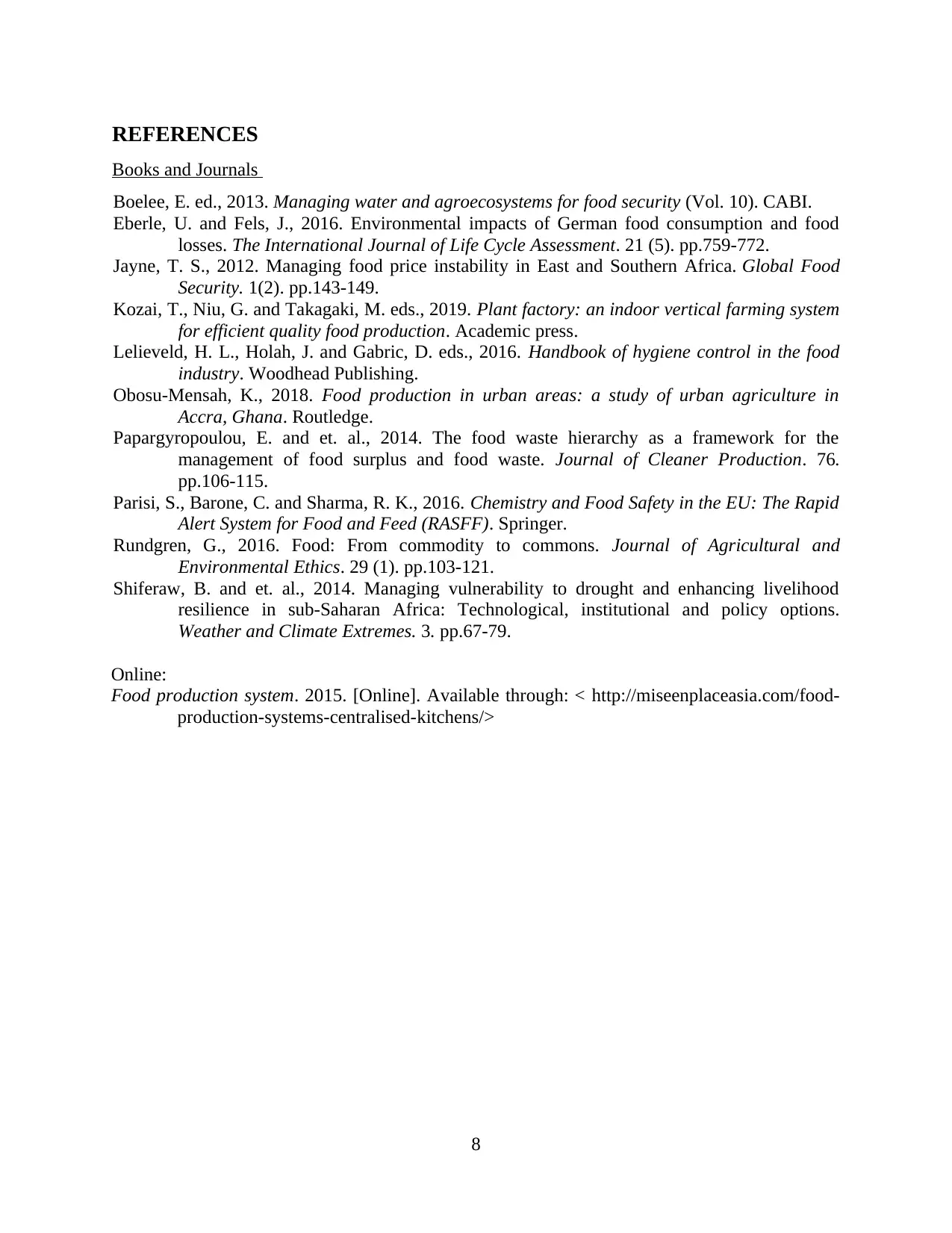
REFERENCES
Books and Journals
Boelee, E. ed., 2013. Managing water and agroecosystems for food security (Vol. 10). CABI.
Eberle, U. and Fels, J., 2016. Environmental impacts of German food consumption and food
losses. The International Journal of Life Cycle Assessment. 21 (5). pp.759-772.
Jayne, T. S., 2012. Managing food price instability in East and Southern Africa. Global Food
Security. 1(2). pp.143-149.
Kozai, T., Niu, G. and Takagaki, M. eds., 2019. Plant factory: an indoor vertical farming system
for efficient quality food production. Academic press.
Lelieveld, H. L., Holah, J. and Gabric, D. eds., 2016. Handbook of hygiene control in the food
industry. Woodhead Publishing.
Obosu-Mensah, K., 2018. Food production in urban areas: a study of urban agriculture in
Accra, Ghana. Routledge.
Papargyropoulou, E. and et. al., 2014. The food waste hierarchy as a framework for the
management of food surplus and food waste. Journal of Cleaner Production. 76.
pp.106-115.
Parisi, S., Barone, C. and Sharma, R. K., 2016. Chemistry and Food Safety in the EU: The Rapid
Alert System for Food and Feed (RASFF). Springer.
Rundgren, G., 2016. Food: From commodity to commons. Journal of Agricultural and
Environmental Ethics. 29 (1). pp.103-121.
Shiferaw, B. and et. al., 2014. Managing vulnerability to drought and enhancing livelihood
resilience in sub-Saharan Africa: Technological, institutional and policy options.
Weather and Climate Extremes. 3. pp.67-79.
Online:
Food production system. 2015. [Online]. Available through: < http://miseenplaceasia.com/food-
production-systems-centralised-kitchens/>
8
Books and Journals
Boelee, E. ed., 2013. Managing water and agroecosystems for food security (Vol. 10). CABI.
Eberle, U. and Fels, J., 2016. Environmental impacts of German food consumption and food
losses. The International Journal of Life Cycle Assessment. 21 (5). pp.759-772.
Jayne, T. S., 2012. Managing food price instability in East and Southern Africa. Global Food
Security. 1(2). pp.143-149.
Kozai, T., Niu, G. and Takagaki, M. eds., 2019. Plant factory: an indoor vertical farming system
for efficient quality food production. Academic press.
Lelieveld, H. L., Holah, J. and Gabric, D. eds., 2016. Handbook of hygiene control in the food
industry. Woodhead Publishing.
Obosu-Mensah, K., 2018. Food production in urban areas: a study of urban agriculture in
Accra, Ghana. Routledge.
Papargyropoulou, E. and et. al., 2014. The food waste hierarchy as a framework for the
management of food surplus and food waste. Journal of Cleaner Production. 76.
pp.106-115.
Parisi, S., Barone, C. and Sharma, R. K., 2016. Chemistry and Food Safety in the EU: The Rapid
Alert System for Food and Feed (RASFF). Springer.
Rundgren, G., 2016. Food: From commodity to commons. Journal of Agricultural and
Environmental Ethics. 29 (1). pp.103-121.
Shiferaw, B. and et. al., 2014. Managing vulnerability to drought and enhancing livelihood
resilience in sub-Saharan Africa: Technological, institutional and policy options.
Weather and Climate Extremes. 3. pp.67-79.
Online:
Food production system. 2015. [Online]. Available through: < http://miseenplaceasia.com/food-
production-systems-centralised-kitchens/>
8
1 out of 10
Related Documents
Your All-in-One AI-Powered Toolkit for Academic Success.
+13062052269
info@desklib.com
Available 24*7 on WhatsApp / Email
![[object Object]](/_next/static/media/star-bottom.7253800d.svg)
Unlock your academic potential
© 2024 | Zucol Services PVT LTD | All rights reserved.





